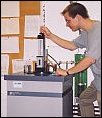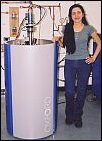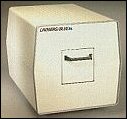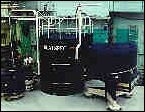
|
|
Research Facilities
|

|
|
We have access to the outstanding facilities operated by the Brockhouse Institute for Materials Research (BIMR) for the synthesis and characterization of inorganic materials.
|

|
|
|

click on picture to enlarge |
This system has been upgraded in 2000 to state-of-the-art sensitivity levels and also features an "oven" insert for high temperature measurements. This instrument can measure d.c. magnetic susceptibility and magnetic moments on samples as small as a few mg over a temperature range from 2 K to 700 K in applied fields from a few Oe to 60,000 Oe.
|
|
|
|
|

click on picture to enlarge |
The D8 has been in operation since July 2000. In addition to the standard Bragg-Brentano mode with Cu-Karadiation, the instrument can be operated in a high resolution mode using an incident beam monochromator, Cu-Ka1 radiation, and a capillary sample mount is available for air sensitive and very small samples. The data are of excellent quality for refinement by the Rietveld method. Available software resources include the Bruker EVA and TOPAS packages which permit qualitative and quantitative phase analysis (EVA) and ab initio structure solution from powder data (TOPAS). We also use most of the standard Rietveld packages such as GSAS, FULLPROF, etc. and the EXPO system for ab initio structure solution. In addition to the Bruker D8, we also operate a Guinier camera for high resolution unit cell determination.
|
|
|
|
|

click on picture to enlarge |
The Oxford MAGLABEXA is multipurpose with separate, user friendly probes for measurement of electrical transport (resistivity and Hall effect), a.c. susceptibility and heat capacity over the temperature range of 2 K to 350 K in applied fields up to 9 T (90,000 Oe). These techniques are critical to several on-going projects, especially in the study of metal/insulator transitions and geometrically frustrated antiferromagnets. [top of page]
|
|
|
|
|
 |
More details can be found on the BIMR website. A partial listing includes several resistance furnaces with atmosphere and temperature control giving access to temperatures up to 1600 oC. Radio frequency induction furnaces extend the upper range to > 2000 oC. Moreover, extensive facilities for growth of single crystals of inorganic materials by high temperature solution (flux growth), Czochralski (pulling from a melt) and lamp-image furnaces (zone melting) are available. These facilities are state-of-the-art and constitute the most extensive investment in crystal growth equipment at any Canadian or indeed, North American university. Vacuum lines and a glove box are available for handling of air-sensitive materials. [top of page]
|
|
|
|
|
 |
We have access to thermal analysis instrumentation including a new (July 2001) Netzsch 409 PC Luxx station with DTA, TGA and DSC measurement heads and a temperature range from ambient to 1600 oC. The system can be used in moderate vacuum and a variety of atmospheres. Also available is a TA Instruments DSC 2910, which operates from –150 oC to 750 oC. [top of page]
|
|
|
|
|

click on picture to enlarge |
A fully automated apparatus for measurement of the thermoelectric power or the Seebeck coefficient was constructed in 1998 by Gisele Amow as part of her PhD research. The system is cooled using a closed cycle refrigerator and the temperature range is from 30 K to 400 K. An important feature is the ability to reverse the thermal gradient which eliminates d.c. offset errors. [top of page]
|
|
|
|
|

click on picture to enlarge |
In addition to facilities operated by the BIMR, we also make extensive use of the x-ray single crystal laboratory within the Department of Chemistry. This laboratory is equipped with two single crystal diffractometers featuring Bruker SMART CCD area detectors, one for CuKa and one for MoKa radiation. More information can be obtained from the departmental website. [top of page]
|
|
|
|
|
 |
Our group makes extensive use of neutron diffraction and other neutron scattering techniques in the characterization of magnetic materials. Neutron diffraction is the single most useful probe of the microscopic magnetic properties of matter. We use the facilities operated by the Neutron Program for Materials Research of the Steacie Institute of the NRC of Canada which are located at the Chalk River Nuclear Laboratory, Chalk River, Ontario. We also carry out experiments at international sites such as the Institut Laue-Langevin, located in Grenoble, France, which is the best facility for neutron scattering in the world at present. We expect to make significant use of the x-ray diffraction instruments that will be available at the Canadian Light Source now under construction in Saskatoon. Muon spin resonance is similar to n.m.r. and is one of the most useful probes of spin dynamics in magnetic materials. These experiments are carried out at the TRIUMF laboratory located at the University of British Columbia. [top of page]
|
|
HOME | NEWS | RESEARCH | GROUP | FACILITIES | PUBLICATIONS | J. E. GREEDAN
© 2009 J.E. Greedan / McMaster University
All Rights Reserved
Last updated:
|











